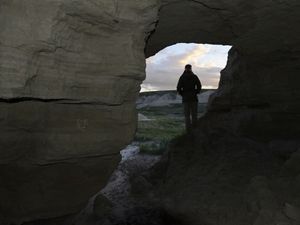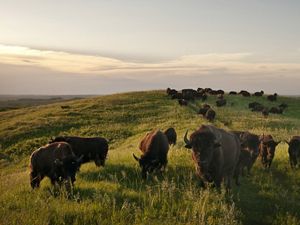Ranchers Unite Behind Nature-Based Solutions for Unpredictable Rainfall
Castle Rock ranchers are investing in unconventional grazing tactics and river stream health with support from TNC and partners.
In northern Butte County of South Dakota’s semi-arid West River rangeland, Markus Erk continues to live by the 60-year conservation ethic of his father, George Erk. Their ranches, homesteaded by Markus’s grandfather in 1912, offer a beautiful vista of Castle Rock.
His father helped grow their Hereford cattle and Rambouillet sheep herds by planting trees to offer livestock shelter and building dams with spreader dikes to channel water across the rangeland.
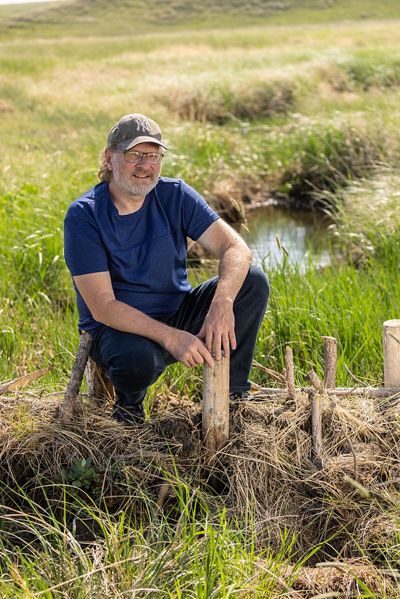
Fast forward to the current decade: Markus continues the investment in the land by focusing on slowing down and saving more water through riparian area improvements in the abundant creeks. By working with conservation groups like The Nature Conservancy and World Wildlife Fund (WWF), and through partnership with neighbors and the Natural Resources Conservation Service (NRCS), he hopes to reduce erosion, increase rotational grazing and improve riparian areas.
Download
Understanding how to manage streams is crucial for landowners and managers.
DOWNLOADThe feast-or-famine rainfall in the region can shift from multiple-year droughts to overnight 4-inch, dam-breaking, gully-washer events. “Our dams have been a lifesaver over the years for our livestock, but recent higher alkali levels in the water have many ranchers around here fencing them off to protect animal health,” Erk explains.
Grant Funding for Riparian Projects
The challenge of unpredictable water flows led Erk to join forces with five ranch neighbors in the same watershed and form the Castle Rock Ranch Water Corporation, which was awarded a Conservation Implementation Strategy grant from the NRCS. The grant will cost share drilling a well and piping fresh water to all the ranches—in exchange for the ranchers adopting more conservation practices.
Another project that excites Erk is The Nature Conservancy’s effort to help heal the riparian environments for healthy stream biodiversity. “The stream analysis by TNC targeted two creek areas where high water creates the most erosion damage,” Erk explains. “Last year, they installed 12 beaver dam analogs and Zeedyk rock structures to slow water, raise the water table, control erosion and help nature begin to restore riparian biodiversity.”
Creating Beaver Dams
Beaver dam analogs (BDAs) are human-made structures that are designed to mimic the function of a natural beaver dam. TNC installed BDAs on the Erk ranch using wood and mud to hold creek water and stop erosion. As silt and water collect to expand the floodplain behind the BDA, more grass and vegetation grow and naturally slow water to create a slowly healing habitat for fish and wildlife, along with grazing animals.
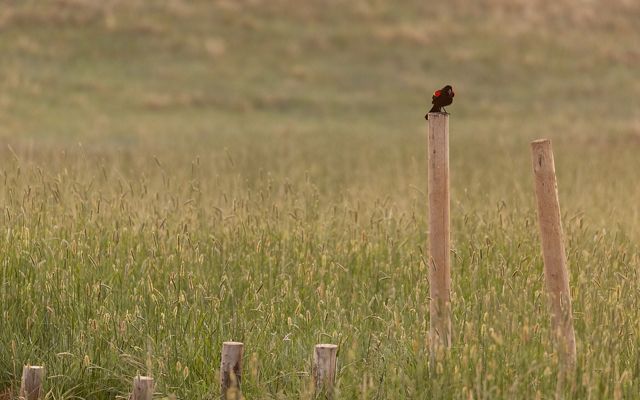
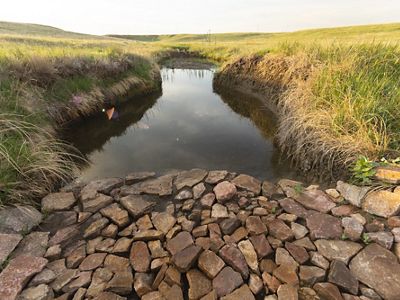
These BDAs are installed using wood posts driven into a stream bed, with tree branches interlaced between the posts to hold them across the stream. Soil is packed onto the branches to contain the flow and create the face of a dam. “It’s very similar to how a beaver would construct a dam using sticks and mud,” Erk says.
In some highly erosive streambed areas, TNC installed a rock floor in the creek, called a Zeedyk structure, to reduce gully formation. Erk says, “It’s a similar technique to installing a stone patio with spaces in between to grow grass. When water flows over it, or a waterfall spills onto it, the structures hold soil in place and allow for vegetation growth between the rocks on the creek bed.”
Want to learn more?
To learn more about whether beaver dam analogues are right for your land, contact Lori Brown, Western South Dakota Rangeland Specialist at lori.brown@tnc.org.

After only one year, the riparian areas that received these creek structures are already showing signs of healing. “While we’re currently in the middle of several dry years, the beaver analogs and Zeedyks are working well to cut down on erosion and hold water to spread it out more. While it’s too early to tell, I’m excited for TNC to install more of these practices,” Erk shares.
So far, more than 350 beaver dam analogue structures have been installed in western South Dakota by TNC and our partners. Although only 1% of western South Dakota grasslands are comprised of streams, 80% of all grassland species depend on streams.
More Grassland, Better Rotational Grazing
Related to ranch riparian health, Erk is also working with Burger King, Cargill and WWF on their grassland restoration project to turn his last remaining fields of marginal cropland into grassland for his livestock.
Quote: Markus Erk

If you take care of the land, the land takes care of you.
“These new pastures, along with the addition of fresh water, will help improve our rotational grazing opportunities,” he explains. “By adding more fencing, we’re improving grazing efficiency, which will improve the grass and help deeper roots store more carbon to improve the soil and our ranch for the future.”
Proud of his conservation heritage, Erk hopes to spread his love of these practices to encourage their acceptance on more ranches throughout West River. “My lot in life follows my dad’s request to ‘be a good steward of our ranches, because if you take care of the land, the land takes care of you,’” Erk says. “Together, with my wife, Candy, and son, Colton, we continue to improve the ranch and hopefully keep it in the family for future generations.”
Sign up for South Dakota Nature News
Get monthly conservation news and updates from South Dakota right to your inbox.




